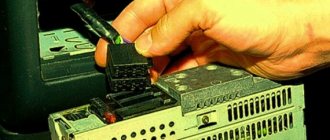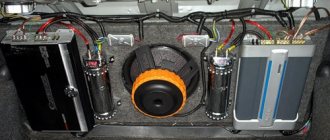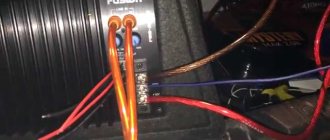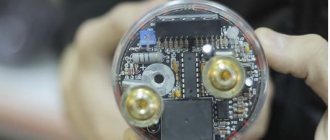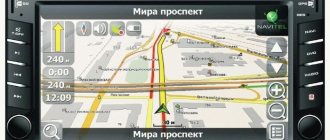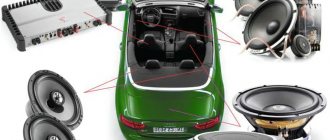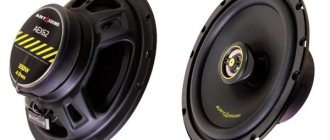In the modern world, every car has a radio and several speakers for listening to radio or music, but car owners are not always satisfied with the playback quality, and they tune the audio system. To improve the quality of the sound output, many install subwoofers and additional speakers, but some forget that this is additional equipment that must be connected correctly.
Car radio
Safety and better sound depend not only on the components of the audio system, but also on the wires through which the signal is transmitted. Which cable to choose for connecting a subwoofer, and what wires are required to connect an active or passive subwoofer?
Connecting an active subwoofer
What wires are needed to connect a subwoofer and amplifier?
- Speaker wires are required to connect the subwoofer to the amplifier.
- To connect the head unit to the amplifier, you need interconnects, or, as they are also called, signal cables.
- And to connect the amplifier to the battery you need to use power wires.
In stores selling car audio products, you can see ready-made connection kits. Those who are not very well versed in the topic may be tempted to buy such a kit so as not to think about how many and what kind of wires they need to purchase. Especially if this kit is cheap.
It’s not worth buying such inexpensive “ready-made kits”.
Firstly: because their length may not be enough for your speaker system, and you will still have to buy more.
Secondly: the quality of such kits often leaves much to be desired. And outwardly they may look good due to thick insulation, but the quality will be disgusting. Because the current-carrying core of cheap wires is usually very thin.
Thirdly: connecting using such a kit can be downright dangerous. After all, bad fuses and thin wires create excellent conditions for short circuits and fires. And by saving on wires, you can lose your car...
Of course, if the manufacturer of the finished kit is a well-known brand, the price of the kit corresponds to its quality, and the length of each component suits you, you can buy such a kit. In other cases, it is better to purchase each wire separately, of the quality and length you need.
Correct installation of car audio
When routing wires under the hood, avoid contact of the wire insulation with the engine. Many types of insulation dry out and crack due to periodic heating by the engine; in addition, the engine vibrates and sways during operation and can grind the insulation.
Place the wires away from the engine fluid filler necks to avoid accidental contact with oil, antifreeze or antifreeze on the wires.
After tightening the wires into the terminals, check from time to time whether the insulation has crawled off the wire near the terminal. Sometimes this happens and under the hood there is an uninsulated section of the power wire on which a screwdriver or wrench tends to fall.
Try to additionally protect the section of the power wire that passes through the engine compartment bulkhead. Put on additional corrugation, for example, or put a rubber ring on the edges of the hole, etc., so that the iron does not cut through the insulation over time.
If you lay a wire in a rubber band with a clutch cable, then regularly check the integrity of the wire. When pressed, the cable may begin to wander and gradually lose power. Ideally, of course, throw the force separately into a personal hole. Cover the transition area with silicone sealant to prevent moisture from entering the interior.
It is best to remove and insert the connector into the radio by first removing the fuse located on the power cable of the radio, or by removing the car terminal.
In the door from the body, pull the wires only in a protective rubber band. If all of them do not fit into one rubber band, then drill holes above for another one of the same type. Otherwise, the wire will quickly damage the insulation and contact ground. And if at least one of the speaker wires goes to ground, the amplifier will go into protection when the volume increases.
If cracks or damage are found in these corrugations, seal the cracks with silicone sealant and, if possible, replace the corrugations. Moisture getting inside the corrugation is highly undesirable.
To run wires through doors, give preference to wires whose insulation does not harden in the cold. Otherwise, in winter, the wires inside the corrugations will crack and short out, causing the equipment to become protected.
It is better not to install midbass in doors with the terminals down. In case of condensation or moisture getting into the door, the moisture will flow directly onto the terminals, which is not good for them at all.
In the doors at the bottom, as a rule, you can find holes for drainage of moisture that can get into the door. These holes often become clogged and need to be cleaned periodically. Especially in soundproofed doors, which are poorly ventilated due to insulation.
When laying wires in doors, make sure that they do not lie at the bottom of the door collecting moisture. Also, make sure that the wires cannot catch the window lifts, otherwise the lifts will easily rip out both the wires and terminals from the speaker when lifting the glass.
When laying wires around the cabin, make sure that the wires are not frayed or crushed anywhere. Also, place the wires where your feet and those of your passengers will not step on them. Take into account the seat sagging when a passenger sits on them.
When attaching the amplifier, check in the instructions whether it is permissible to connect the amplifier body to the car body. In some amplifier models, the manufacturer suggests avoiding this. If there is such a limitation, then check whether the screws that secure the amplifier are installed on the body and how to prevent the amplifier from accidentally touching the body elements.
If the amplifier has clamps for male terminals, then provide the wires with them, or before clamping the wire, divide the wire into 2, insert it on both sides of the bolt and then clamp it to prevent distortion.
If the amplifier is equipped with screw terminals specifically for the wires, then do not tin the clamped wires. Clean until shiny and tighten.
Also, in such clamps, do not pull wires that are significantly smaller than the permissible cross-section of the clamp. If there is such a need, fold the core several times and then clamp it.
After assembling the system, tighten all wire clamps over time. Copper shrinks over time, weakening the contact, so pulling all connections is simply necessary 2-3 times during the first 2-3 months of system operation.
Do not string the wires to the amplifier. This will also weaken the contact over time. And don’t hang sagging wire snot around the trunk. It’s easy to snag and break such a wire. And yes, these noodles look like crap.
If the amplifier is on a reclining backrest, secure the wires in front of the amplifier terminals so that when reclining the wires do not bend directly near the terminals. This is especially important in winter when the wire insulation becomes tougher.
In the cold winter, do not turn up the volume of the subwoofer until the interior has warmed up sufficiently. Otherwise, you risk tearing the diff and suspension, which become dull in the cold. Even if you “have already turned it on a hundred times and everything was fine.” This “normal” only means that you are lucky people.
It is not recommended to turn on the equipment at all if the temperature in the cabin is below -6. Warm up the interior and then turn it on.
Make any connections to disconnect the equipment only by turning off the system and de-energizing the positive power wire.
Even if you “have already turned it on a hundred times and everything was fine.” Unless by switching interblocks you can not de-energize the plus. In this case, be sure to turn off the equipment. You also need to ensure that the interconnects do not accidentally touch the power positive on the terminal.
If you need to disconnect a separate speaker from the amplifier to check, then disconnect both contacts at once and isolate them.
If for some reason you need to connect the amplifier under voltage, then first connect the minus, then the plus, and then the repair wire, being careful not to short the + to the amplifier body with a screwdriver. You need to turn off the system in the reverse order.
If there is a drive in the system, then after turning off the power it must be discharged with a light bulb or a suitable consumer.
Never ask on the Internet how this or that equipment sounds or ask for advice on personally recommending something for your system.
The fact is that, as I said, everyone’s systems, settings, machines and ears are different! What may sound great to one person will be ear cancer to another. Any advice on the Internet will give you absolutely nothing and will only confuse you more.
Not even the most competent review of a professional about acoustics, say, will give you an idea of how your ears will evaluate the sound when the same component is operating in your system.
In addition, 4/5 of the advisors on the Internet have absolutely no idea what they are advising. Their knowledge in this area is limited to reading advice on the Internet from the same “experts” like them and nothing more. I think there is no need to explain that such advice is not only stupid, but also often dangerous for your equipment.
The maximum that can be taken into account on the Internet is reviews about the reliability of any component, its functionality and ease of working with it.
Never listen to equipment on display in stores. This stupidity especially applies to listening to midbass and subs.
Listening in a store will not give you any idea how this component will play in your car. Car equipment is built taking into account the nuances of car acoustics. Without them, the sound will change beyond recognition, turning your wiretapping in a store into a stupid undertaking.
Never buy acoustics based on your favorite genres of music.
Avoid the most common myth about speakers, which says that they can (should) be selected based on the preferred genres of music. In general, it is partly true that in some combinations some genres will play more pleasantly and some less. But these conclusions will only be valid for a single system in a single machine and for individual listener ears.
Another person will find a completely different genre enjoyable on this equipment, and a third person will generally say that this combination is unacceptable to his ear. All these are individual things and taking someone else’s opinion in the hope that it will coincide with yours is not practical.
Never ask the Internet for advice on subwoofer design, box parameters or bass reflex settings.
It is partly true that some subs gravitate towards a particular type of design, but this is not all subs. The setup is also individual for your car and ears, as is the selection of speakers by genre.
That box and speaker that someone else thinks plays great, if repeated in your opinion, can completely disappoint you. Designing a subwoofer is generally a more creative process, and to achieve good sound you have to experiment several times with cutting test boxes with different settings and volumes. Internet advice in most cases will not give anything. Using them you can only get an idea of the range of volumes and settings of the box for your speaker in which you will have to dance.
It remains only to advise, before choosing the structure and direction of the system in general and its components in particular, to listen to as many different systems as possible on different components and in different directions.
Moreover, it is better to listen to the components in a car with an interior similar to yours. Such experience will allow you to objectively understand what you need from the sound, what kind of sound is yours and on which components, boxes and settings this can be achieved most easily and cheaply. Well, it will save you from wasted time, effort and money.
Well, I would also like to separately mention those people who rush to install sound in the car with absolutely no idea how to do it competently, preferably in 1 evening and with beer, and then tell everyone that “it’s all too much, and all these subtleties and nafik I don’t need to go to competitions” and mention those who think: “I have cheap equipment, why bother with it.” I want to tell you that with a stupid approach you can ruin the sound of even the most top-end components, and on the contrary, with a smart approach you can make even the most budget components sing quite well.
If you approach the issue of sound hastily and without bothering, you will, without any options, get a crappy sound with a collective farm insall and there is no talk of any competitions at all. You can simply spend your money wisely and get good sound, unlocking the full potential of the system both in volume and quality. Or you can drive by wearing glasses, hanging your hand out of the window, and resounding the surrounding area with wheezing, crackling and farting from the speakers, causing laughter and condescending smiles of passers-by.
What quality should the wires have?
It is best to purchase wires made of copper with good flexible insulation that does not crack in the cold. Copper-plated aluminum is a bad option. But what kind of wires are needed to connect the subwoofer, branded ones or from the nearest electrical goods store? Practice shows that there is no big difference in sound.
But a wire made from electrical goods may look simpler, and its insulation will not be as high quality. But the price will be significantly less. Good branded wires are usually made of high quality, their insulation is flexible and durable, they look chic, but they can cost the same as, for example, the subwoofer that you are going to connect.
How to connect minus
The cross-section of the cable for connecting the minus to the subwoofer can be taken a little smaller than for supplying the plus. And you will need a shorter cable length of about 1 meter. If the subwoofer power is more than 500 W, do not attach the negative wire to the body. It must be stretched to the battery.
The minus in this system can be supplied from the machine body. But find some reliable connection that will ensure good contact and secure fit. For example, you can extend the negative cable from the seat mounting bolt. If the subwoofer is located at the rear, away from the rear seat. But without twists and other unreliable connections.
Example of minus connection
Under the bolt, take a terminal with a hole in the middle of a suitable size, and not in the form of a “plug”. Unscrew the bolt, clean the head and rod, the edges of the hole, put on the terminal from the cable and install it in place. Lay the route so that the possibility of damage is minimal.
You can find an area that has been cleared of paint and screw the negative cable there. But not with self-tapping screws, but with a bolt. And remove dirt and rust, if any. Drill a hole in clean metal and drive a bolt into it with a contact from the negative cable mounted on it. And the contact must be very strong and tight.
Acoustic cable
The speaker cable must be thick and copper. For most systems, a cross-section of 4 mm² is sufficient.
For powerful subwoofers, you can use 6 mm², but you need to see if the terminal on the speaker will allow you to insert such a wire.
By the way, by trying speaker wires of different thicknesses, you can feel how the thickness affects the sound quality. The thinner the wire, the worse the bass will be.
If the amplifier is placed in the trunk, near the subwoofer, then you need a little speaker wire, 50-100 cm.
Connection diagram to a free channel on the radio
Not always all 4 speakers are installed or connected in the car. In this case, you can connect a passive subwoofer to a free channel on the radio. The positive output is connected to a similar input on the speaker, and the negative output is connected to the negative one.
Connecting a passive subwoofer to the radio
If you install a speaker in a homemade housing, then in this case it is better to place a low-pass filter in front of the subwoofer to separate the reproduced frequencies. It can be LC, RC or RLC.
Low Pass Filter
When connected to an amplifier, no additional filters are needed. The amplifier itself separates the frequencies. So you only need to connect the sub to the low-frequency outputs.
The factory sub already has a pre-installed filter. In self-made, you need to make it yourself. There are formulas for calculating the filter, they are quite complex. For an LC filter, the inductance is L = R / (2π × Fc), where Fc is the cutoff frequency and capacitance C = 1 / ((2π × Fc)2 L).
There are several ready-made solutions. For a 4 ohm speaker and a cutoff frequency of 220 Hz, the capacitance of the capacitor will be 255 µF and the inductance 4 mH. For an 8 Ohm speaker with a cutoff of 250 Hz, C = 112 µF and 7.2 mH.
What should the interconnect cable be like?
The highest quality you can afford. The connectors should be made of reliable material that would not break after several connections, and the cable itself should be well shielded, since it is the interconnect that picks up interference the most.
By the way, the interconnect cable is the most expensive of all the wiring needed to connect a subwoofer and amplifier. Some car audio enthusiasts make their own interconnect cables. It's not as difficult as it might seem. You need to buy connectors, a high-quality cable and solder it all correctly. Instructions can be found in the article “Do it yourself interconnect cable” on our website.
The interconnect cable, when placing the amplifier in the trunk, is needed about 4-5 meters long. It will be better if you measure the required distance with a tape measure before purchasing. You don’t need to calculate back to back, but you shouldn’t make a large reserve either.
Selection of section
Correct selection of this parameter is one of the main keys in choosing the right wire.
For correct selection, it is necessary to calculate the consumption of the amplifier and additional equipment. To make the calculation, you need to add up the rated power of the channels, multiply it by 2 (maximum power) and divide by 13 (on-board voltage). For example, to calculate the cross-section for a standard 4-channel subwoofer with a power of 50 * 4 W, you need to calculate using the following formula: 4 * 50 * 2/13 = 30. This means that the amplifier needs 30 Amperes.
After this, you need to calculate the length of the wire. Most car enthusiasts install additional equipment under the front seats or in the trunk. For installation under the seats you will need about 3 m of cable, and for installation in the trunk - 5 m.
After the above calculations, you need to select the cross section by finding the desired value in the table:
| Current (Ampere) | Wire size (m) | |||||||
| 0-1.2 | 1.2-2.1 | 2.1-3.0 | 3.0-4.0 | 4.0-4.9 | 4.9-5.8 | 5.8-6.7 | 6.7-8.5 | |
| Sectional area (Ga) | ||||||||
| 300-225 | 1/0 | 1/0 | 1/0 | 1/0 | 1/0 | 1/0 | 1/0 | 1/0 |
| 225-150 | 2 | 1/0 | 1/0 | 1/0 | 1/0 | 1/0 | 1/0 | 1/0 |
| 150-125 | 2 | 2 | 2 | 2 | 1/0 | 1/0 | 1/0 | 1/0 |
| 125-105 | 4 | 4 | 4 | 2 | 2 | 2 | 1/0 | 1/0 |
| 105-85 | 4 | 4 | 4 | 2 | 2 | 2 | 2 | 2 |
| 85-65 | 4 | 4 | 4 | 4 | 2 | 2 | 2 | 2 |
| 65-50 | 8 | 8 | 4 | 4 | 4 | 4 | 4 | 2 |
| 50-35 | 8 | 8 | 8 | 4 | 4 | 4 | 4 | 4 |
| 35-20 | 8 | 8 | 8 | 8 | 8 | 4 | 4 | 4 |
| 20-0 | 10 | 10 | 8 | 8 | 8 | 8 | 8 | 8 |
This means that knowing the necessary characteristics, selecting the cross-sectional area is not difficult and you can choose the wires yourself.
